 |
 |
 |
 |
|
Nada Swaroopam
At the beginning there was sound - Nada Brahma - the sound of God. Through this sound, we perceive the whole world and also
God. Nada Swaroopam explores this concept beginning with sound symbolising creation, followed by rhythm and pure dance that
emanated from sound. It goes on to explore preservation of the universe by Lord Krishna and destruction and purification by
Lord Shiva. At the end, through Nada, the artiste becomes one with the universe. The production uses the versatility of the
two Eastern Indian classical dance styles Manipuri and Odissi including the Pung (percussion) and Manjira (cymbals) being
played on stage by dancers. Concept, direction and choreography by Poushali Chatterjee (Manipuri) and Arpita Venkatesh (Odissi)
along with artistes of Nandanik and Malashree.
Hridayanandan: Navarasa in Tagore's Dance Dramas
It is a choreography exploring
Navaras or the nine sentiments in Tagore’s dance dramas, using the various styles of Manipuri Dance like Jagoi, Cholom,
Lai Haraoba and Thang-ta (martial arts).
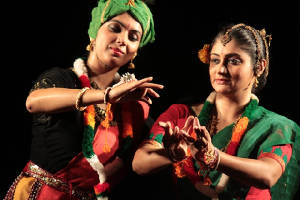
Shringar (love): This is depicted through
the cosmic love of Lord Krishna and Radha which forms the basis of Tagore’s Bhanushingher
Padavali.
Hasya (laughter): In Kalmrigaya, the Bidushak or court jester's interactions with the hunters, who tease him and try to drag
him to hunt with them evokes the comic feeling.
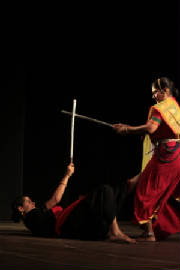
Bir
(bravery): In Chitrangada, we find the princess of Manipur brought up like
a prince, engaged in learning the art of warfare and hunting with her friends. Bravery, physical power and courage are epitomised
by Rajkumari Chitrangada.
Bhayanak (horror): In Tagore’s Shyama,
the merchant Bajrasen is wrongly suspected of stealing the king’s precious ring. Shyama convinces Uttiya, her devoted
lover, to take the blame upon himself. The cruel and violent slaying of Uttiya by the Royal guard evokes horror and terror.
Karun (grief): When the brave Chitrangada meets Arjuna in the forest, its love at first sight for
her. But Arjuna rejects her, citing his celibate state as the reason. Chitrangada realises that she lacks feminine grace –
rejection by her loved one evokes sadness and grief in her.
Bibhatsa
(disgust): In Chandalika, Prakriti's mother calls forth the evil forces
which torture Ananda – evoking the feeling of disgust.
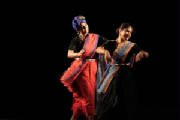
Roudra (anger): When Bajrasen learns about Shyama’s deceit which made the innocent Uttiya give
up his life, violent anger grips him. In spite of Shyama’s pleas, he refuses to forgive her.
Adbhut (wonder): In Tagore’s Taasher Desh, the living and breathing cards follow strict rules of their own, most of which seem funny and
fantastical to the humans, thus evoking wonder in them.
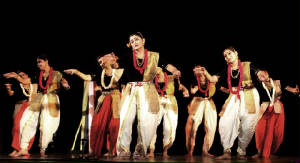
Shanta (peace): The feeling of peace and tranquility can only be achieved by complete submission to
the almighty. Tagore’s song of worship ‘Hridayanandana bane’ creates
an atmosphere of peace and harmony. With this, the production covers the Navarasas, or the nine sentiments of which form the
body of Abhinaya or expressions in Indian dance.
Bande Mataram: A Hymn to Mother Earth
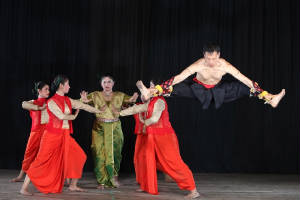
Bande Mataram: A Hymn to Mother Earth
This production aims to create awareness about the destruction of the earth’s
ecosystem by human beings. It views the earth as a mother, who gives birth to a child, nurtures it, supports it, only to be
disregarded and attacked by the child when he grows up.
The production shows the interaction between the mother and
child and earth and human beings side by side. Each stage in the life of the child and the harm it inflicts on its mother,
both physical and mental, is reflected in a similar act of harm inflicted by man on nature – the cutting down of trees,
industrialisation and the creation of weapons of destruction. The choreography unfolds through this juxtaposition of the individual
and the universal, the idea being to bring the pain felt by earth much closer home by comparing it with the pain a mother
feels when her child turns against her.
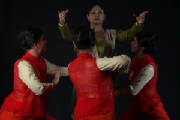
The mother finally decides to punish the child just as the
earth is now punishing man with a spate of natural disasters. Man has to return to the first stages of life where there was
perfect harmony between man and nature.
The choreography uses ancient Manipuri nativity rites to
show creation of the universe and birth of a child. It also uses Thang-ta, the Manipuri Martial Arts along with the classical
Manipuri dance form to depict various situations.

Patakatha: A Story of Evolution
PataKatha
is a dance drama based on Manipuri Dance styles, which traces the evolution of a community of rural performers in West Bengal who create Pata or scroll paintings.
This
is the tale of a Potua or Chitrakar, whose art is under threat in this cyber age. Though their paintings and songs on religious
and mythological themes were very popular in the rural and urban society, new forms of entertainment and new social issues
have led to dwindling interest in their art.
The
production portrays the Potua’s glorious past, her rude awakening to ever new needs created by modern society and her
consequent re-inventing of her own art and adapting to the challenge posed by modern entertainment.

The production traces the story of the Potua - starting with the story of Sita Haran (Sita's
Abduction) from Ramayana in a live performance by a Potua and the dancers, using martial art techniques and Manipuri sound
instruments to create a dramatic effect. Then it shows the evolution of colours from natural elements and the potua's inspiration
from the world of animals and birds. Then we see two stories told by the Potua enacted through dance. After that, the choreography
shows the dwindling of the potua's fame as new forms of entertainment take over. To keep up with the times, the Potua then
decides to sing of modern themes. The production ends with a live rendition of the Tsunami song that completes the evolution
of the Potua from propagators of ancient mythology to commentators on modern themes.
|
 |
|
|
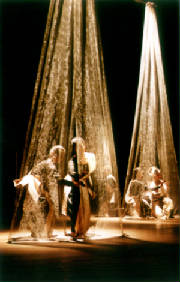
|
| Sama, the opening sequence |
Sama - The Harmony of Life
This production offers a rich tapestry, comprising of varied
elements like Manipuri Classical and Folk dances, Thang-Ta, the Martial Arts, Odissi Classical and Folk, Puppetry and philosophy
and literature from Vedas, Upanishads, the poetry of William Wordsworth, Shelley, T S Eliot and the lyrics of Simon &
Garfunkel. Combining these elements into a seamless whole, Sama delivers a message that is very relevant to this day and age.
There is a rhythm in the workings of the universe. Right from
the cosmic cycles, the planetary movements, the rise and fall of tide to the human life cycle. The child is rocked to sleep
in his cradle, he learns to walk when one foot co-ordinates with the other. His rapid growth from a fledgeling to a mini human
is like a cosmic dance in itself. Even as he grows up, other rhythms govern his life - the rhythm of friendship, of carnal
love, of social relationships. However, in our increasingly self-centric world, these rhythms are being shattered everyday.
Friendships die, love becomes a restricting chain, intolerance rules our blind existence in the social sphere.

|
| Love in chains |
But all is not lost. There is one power that can rise above all our petty fights, the power of love
which can break all the barriers we have created. Just as one dance style exists side by side with another on the same stage,
without either of them losing their identities, let us welcome every religion, language, caste, community and opinion to share
the same place under the sun. Let us say, along with T S Eliot, 'In my end is my beginning'.
Sama is a universal vision of harmony portrayed by the fusion of two classical dance styles of India,
Manipuri and Odissi. It reminds one of the importance of harmony in life by highlighting its essential presence in the human
life cycle. The co-ordination between the two dance styles ensures that the medium and the message become one - Sama, the first
beat of music where all rhythms converge, the glorious oneness of human character all over the world.
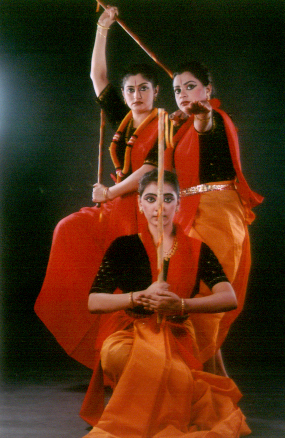
|
| The raging flame |
| Invocation to fire |

|
Agni - The Life
Force
This is an experimental composition portraying fire as one of the driving forces of life. Fire
has had a role to play in human life since the beginning of civilization. It is the embodiment of energy, sometimes positive
sometimes negative. It nurtures with its warmth, but also destroys with equal force. Its something like the fires of passion,
which can be mellow and life-giving and sometimes violent and destructive, like a volcanic eruption or a forest fire that
destroys plant and animal life. The only thing that can control fire is rain, which reduces it from a destructive blaze to
a smouldering flame.
This composition uses the various aspects of Manipuri Dance Lai Haraoba, Tandav, Lasya
and Thang-Ta (martial arts).
'Icche - Shei to Bhangche, Shei to
Gorche'
Based on a short story by Rabindranath Tagore titled Suoranir Saadh, Icche is a modern choreography that reflects
modern society with its over consumption and opulence. Its a simple tale of how a human being is never satisfied with his
or her lot in life. Even after being blessed with the best material possessions, human beings are running after that which
is not their own. It is a primeval urge to possess what others have and just as it affects people who are poor it also affects
those who apparently have everything that love and money can buy.
Using poems and songs of Tagore, as well as narration
from the original story, this production uses all the aspects of Manipuri dance - Lai Haraoba, Rasleela, Cholom and Thang-ta,
to deliver a powerful message on the modern culture of discontentment. Premiered at the celebration of Tagore's birthday in
May 2004 in Kolkata, the production received wide acclaim.
Scroll down for Press Reviews
|
   |
 |
|
|
 |
   |
 |
|
|
 |
|
|
|
|
 |
 |
 |
 |
 |
Critics' Comments
Sunil Kothari in The Pioneer, New Delhi, 18th March, 2003
"Using the refrain of 'there is a rhythm in the workings of the universe,' they (Poushali &
Aloka) created beautiful vignettes where imagination, cohesive movements and arresting visuals seemed to coalesce in seamless
boundaries...thanks to a bare 55 minute duration, the plot was unfolded in quick succession. Themes of abstract nature, attempted
through the movements of dance in two diverse styles, drew common meeting points....for Poushali...a positive step in experimental
and exploratory aspects"
The Pioneer, New Delhi, 10th November, 2003
A fusion of Manipuri and Odissi dances under the batons of Poushali Chatterjee and
Aloka Kanungo managed to create a concept of universal harmony at IHC recently. Sama opened with a picturesque setting of
translucent curtains through which emerged the barest of hand-gestures, foot movements and body postures...The two forms perfectly
intertwined and interlaced with and against each other to reveal all stages of life. There was the unmistakable accent on
the essential rhythm of the universe from the microcosm to macrocosm. On the whole Sama had a well-conceived theme. The message
came through well.
Sunil Kothari, Nartanam, July-Sept, 2003
Of late Poushali has ventured into choreographing contemporary themes, abstract and
issue based. Agni was an attempt to explore other forms like Lai Haraoba and also maritial arts Thang Ta, taking three elements
of Fire Agni, the burning heat, Energy and its control by Rain. A welcome attemptit had good visual appeal.
Sananda Magazine, Kolkata, 30th August, 2003
Poushali has learnt her craft carefully, and while wandering the realms of music
and tala, she has perceived the beauty of rhythm everywhere in the blossoming of flowers, in lullabies and social relationships.
Sama that which binds all tala together, is the subject of her new production. Like the subject matter, she has tried to bring
harmony in the medium too, using the fusion of two dance styles. It is commendable that Poushali has structured her production
in the form of dance theatre...her use of Thang-ta is powerful and sharp. Some stage props were very attractive... the chain
to project the clash of egos was both aesthetic and appropriate, while the use of a mirror image reminded one of Birju Maharajs
old composition. We can hope for more original creations from the artiste in future.
Leela Venkataraman in The Hindu, New Delhi, 8th August, 2003
Drawing on the rich vocabulary of movements from Lai Haraoba, Thang-ta and Manipuri,
Poushalis contemporary composition Agni was an abstract creation built around the theme of fire as a nurturing and a destructive
force...dance images were powerful.
Hindustan Times, Kolkata, 10th March, 2003
"...a laudable effort at fusing two dance forms into a balletic presentation. The choreography,
handled by Poushali Chatterjee...is a remarkable attempt at achieving oneness notwithstanding diversities. Poushali, an exponent
of Manipuri, mridang playing and Thang-Ta shows amazing depth in conceptualising Sama and executing the nuances of her dance
form. Her dedication is evident in all aspects of the production - music, costumes and sets - contributing to a successful
presentation of the eternal harmony of life"
The Asian Age, New Delhi, Mumbai & Kolkata, 30th March, 2003
"Hauntingly ethereal and expressive, Manipuri exponent Poushali Chatterjee weaves a mosaic of
traditions in each whirl. Her's is a conversion from mortal shape to divine grace....Little wonder then that sheer poetry
is written when sensuous ease doubles with lithe steps to stage an act. That best describes Sama - The Harmony of Life, a
production that fuses the best of two Indian classical dance traditions."
The Telegraph, Kolkata, 14th March, 2003
"Sama: The Harmony of Life attempted a fusion of Manipuri & Odissi to present a unique concept
of harmony amidst negative, divergent forces... Harmony and rhythm are integral to nature, Chatterjee contends, though we
tend to break away from it in order to meet self-centric needs...A vibrant, meaningful choreography traces this eternal dilemma
through enactments of negative forces and human vices leading to war, death and destruction. Merging folk with classical,
the plaintive notes of the flute with western symphony and the rustic bawdiness of Torja with the finesse of a polished series
of taranas spells sharp musicality of purpose in conceptualisation and direction. The sheer originality of thought and the
strength of visualisation are equally commendable"
Bartaman, Kolkata, 28th March, 2003
"...two accomplished dancers Poushali Chatterjee and Aloka Kanungo presented an
extraordinary choreography combining the two dance styles of Manipuri and Odissi. "
Ananda Bazar Patrika, 12th April, 2003
"...A beautiful subject matter is given deserving execution with the help
of the two dance styles. All the dancers contributed immensely to the success of this programme."
The Statesman, Kolkata, 30th May, 2003
"A number of ideas have been incorporated and accommodated in this drama of life. The concept
speaks of the co-existence of two different dance styles without any of them hurting the other...The audience was fed with
a good blending of Manipuri and Odissi. Ranjeet Chingtham's Thang-ta choreography and the puppetry helped exposing the theme
and provided visual enjoyment"
|
 |
|




